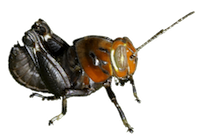Family (Alpha): ACRIDIDAE GRYLLACRIDIDAE GRYLLIDAE GRYLLOTALPIDAE RHAPHIDOPHORIDAE ROMALEIDAE TETRIGIDAE TETTIGONIIDAE TRIDACTYLIDAE
View Gryllidae Members:
Acheta domesticus Anurogryllus arboreus Gryllus unidentified species Gryllus firmus Gryllus fultoni Gryllus pennsylvanicus Gryllus pennsylvanicus/veletis Gryllus pennsylvanicus-veletis Gryllus rubens Gryllus veletis Miogryllus verticalis Velarifictorus micado Hapithus agitator Orocharis unidentified species Orocharis luteolira Orocharis saltator Cycloptilum unidentified species Cycloptilum bidens Cycloptilum pigrum Cycloptilum slossoni Cycloptilum tardum Cycloptilum trigonipalpum Cycloptilum velox Myrmecophilus pergandei Allonemobius allardi Allonemobius fultoni Allonemobius griseus griseus Allonemobius griseus funeralis Allonemobius maculatus Allonemobius socius Allonemobius sparsalsus Allonemobius tinnulus Allonemobius walkeri Allonemobius unidentified species Eunemobius carolinus Eunemobius confusus Eunemobius melodius Eunemobius unidentified species Neonemobius cubensis Neonemobius palustris Neonemobius variegatus Pictonemobius ambitiosus complex Pictonemobius ambitiosus Pictonemobius hubbelli Oecanthus unidentified species Oecanthus celerinictus Oecanthus exclamationis Oecanthus fultoni Oecanthus latipennis Oecanthus nigricornis Oecanthus niveus Oecanthus pini Oecanthus quadripunctatus Neoxabea bipunctata Phyllopalpus pulchellus Anaxipha delicatula Anaxipha exigua Anaxipha litarena Anaxipha rosamacula Anaxipha thomasi Anaxipha tinnula Anaxipha tinnulacita Anaxipha tinnulenta Anaxipha vernalis Anaxipha unidentified species Cyrtoxipha columbiana Falcicula hebardi Gryllidae unidentified species NC Records
Pictonemobius hubbelli Walker & Mays, 1990 - Hubbell's Ground Cricket
No image for this species.
Taxonomy
Family: Gryllidae
Subfamily: NemobiinaeTribe: PteronemobiiniComments: One of four species in this genus, all of which are endemic to southeastern North America (Gross et al., 1989; Cigliano et al., accessed 2021-10-10). As many as two species may occur in North Carolina; the other two are primarily or exclusively Floridian.
Identification
Field Guide Descriptions: Online Photographs: SINA, Google Images ,
iNaturalist , GBIF Technical Description, Adults/Nymphs: Gross et al (1989)SINA 528a.htm Comments: As in other members of this genus, a distinctive pale stripe exists between the eyes on the frons. This species may be superficially indistinguishable from ambitiosus (see key in Gross et al., 1989), although the body in hubbelli is dark gray-brown but may be more reddish-brown in ambitiosus. In both of these species the hind femora possess two longitudinal stripes and the dorsal field of the tegmina in the males have a pale border. The two other species lack these characters.Structural Features: Femur length is 5.8 mm in the holotype male and 6.11 mm in the allotype female (Gross et al., 1989). The ovipositor length is 6.07 mm in the allotype. Singing Behavior: Male calling songs consist of short trills (= "chirps" as defined by Gross et al., 1989), separated by pauses of uniform length. The pulse rate in hubbelli is the slowest of the four species identified by Gross et al., ranging from 29 to 42 PPS. The trill length is generally 1 sec. but was 1.5 seconds in a South Carolina population and 0.5 in some populations further south (Gross et al., 1989). The dominant frequency at 25 C is 6.4 kHz (SINA, accessed 2021-10-10) and the pulse rate at that temperature is 38 PPS (Gross et al.).
Distribution in North Carolina
County Map: Clicking on a county returns the records for the species in that county.
Adult Dates: Click on graph to enlarge
Habitats and Life History
Habitats: The habitat described for this species by Gross et al. (1989) consists of open pine and oak woodlands, including grass tussocks next to pond edges in such habitats. Our record from Moore County comes from a somewhat disturbed, barrens-like habitat dominated by xerophytic oaks with only sparse grasses and other herbs. Diet: Probably omnivorousObservation Methods: Males sing primarily during the day and are most easily detected by their songs (Gross et al., 1989)Abundance/Frequency: Locally common at the one site where this species has been documented so farAdult Phenology:
Status in North Carolina
Natural Heritage Program Status: [W3]Natural Heritage Program Ranks: [GNR] S1S3State Protection: Comments: Only one population has been documented in North Carolina. More information is needed to confirm its identity and distribution within the state, but it is likely to be confined to xeric sandhill scrub habitats in the southern half of the Coastal Plain.
Image Gallery for Pictonemobius hubbelli - Hubbell's Ground Cricket Recorded by: Steve Hall and Bo Sullivan

 »
»
 »
»